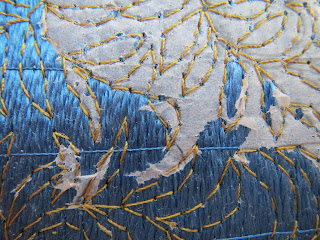Although I was not at the point where I was ready to stitch the wisteria design on the ladle, I wanted to make sure that I learnt the technique during class. I had previously done the stitch transfer and removed the tissue paper.
© JEC/Carol-Anne Conway
On the sake box, I had used different coloured couching threads to demark different elements; red couching thread for the red cords, gold couching thread for the gold work. I repeated this on the ladle. As the whole of the outside of the ladle is superimposed with goldwork, I did the stitch transfer in yellow couching thread.
When I had finished the goldwork on the sake box and came to remove the stitch transfer, the task was made much easier by the simple (and accidental) fact that I had done the stitch transfer with yellow couching thread but had used red couching thread to couch the gold with.
On the ladle I used gold couching thread to couch the gold threads but I had also used the gold couching thread to do the stitch transfer. Distinguishing, and removing, the stitch transfer after doing the superimposed goldwork would prove to be neigh on impossible! But it would be a long time before I discovered this!
© JEC/Carol-Anne Conway
Happy stitching






